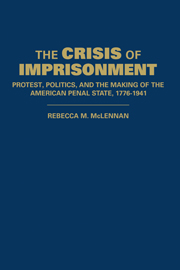Book contents
- Frontmatter
- Contents
- Acknowledgments
- Introduction: The Grounds of Legal Punishment
- 1 Strains of Servitude: Legal Punishment in the Early Republic
- 2 Due Convictions: Contractual Penal Servitude and Its Discontents, 1818–1865
- 3 Commerce upon the Throne: The Business of Imprisonment in Gilded Age America
- 4 Disciplining the State, Civilizing the Market: The Campaign to Abolish Contract Prison Labor
- 5 A Model Servitude: Prison Reform in the Early Progressive Era
- 6 Uses of the State: The Dialectics of Penal Reform in Early Progressive New York
- 7 American Bastille: Sing Sing and the Political Crisis of Imprisonment
- 8 Changing the Subject: The Metamorphosis of Prison Reform in the High Progressive Era
- 9 Laboratory of Social Justice: The New Penologists at Sing Sing, 1915–1917
- 10 Punishment without Labor: Toward the Modern Penal State
- Conclusion: On the Crises of Imprisonment
- Select Bibliography
- Index
5 - A Model Servitude: Prison Reform in the Early Progressive Era
Published online by Cambridge University Press: 18 August 2009
- Frontmatter
- Contents
- Acknowledgments
- Introduction: The Grounds of Legal Punishment
- 1 Strains of Servitude: Legal Punishment in the Early Republic
- 2 Due Convictions: Contractual Penal Servitude and Its Discontents, 1818–1865
- 3 Commerce upon the Throne: The Business of Imprisonment in Gilded Age America
- 4 Disciplining the State, Civilizing the Market: The Campaign to Abolish Contract Prison Labor
- 5 A Model Servitude: Prison Reform in the Early Progressive Era
- 6 Uses of the State: The Dialectics of Penal Reform in Early Progressive New York
- 7 American Bastille: Sing Sing and the Political Crisis of Imprisonment
- 8 Changing the Subject: The Metamorphosis of Prison Reform in the High Progressive Era
- 9 Laboratory of Social Justice: The New Penologists at Sing Sing, 1915–1917
- 10 Punishment without Labor: Toward the Modern Penal State
- Conclusion: On the Crises of Imprisonment
- Select Bibliography
- Index
Summary
(E)mployment is still enjoined upon the State; the contract system is prohibited. Thus the manner, but not the matter, of penal servitude is affected.
Justice Judson S. Landon, Supreme Court of New York, 1897In 1900, the state of New York sent an elaborate scale-model of one of America's oldest and most infamous prisons, Sing Sing, to the International Exposition in Paris. Meticulously crafted by a convict reputed to have learned the art of model-making in St. Petersburg, Russia, the structure was illuminated from within by tiny strings of light bulbs. These brightly alerted viewers to one of New York's latest penal reforms: the installation of electric lighting in Sing Sing's old stone cellblock. All underground pipes were clearly marked so as to advertise the recent installation of modern plumbing in administrative and industrial buildings. The intricate model also had automated front gates, which viewers could operate from within the model's tiny guardhouse, and movable alabaster walls that swung open to reveal the clean, bright interior of the model prison's cellhouse. Spectators were instructed that once the International Exposition was over, the model would be returned to the warden's office at Sing Sing, where it would be used as an aid for locating prison fires.
Whether or not the Sing Sing miniature presented a “realistic” picture of life inside New York's prisons, circa 1900, it was a fitting emblem of the sweeping series of penal reforms upon which the Empire State had embarked just three years earlier, when the last few private contractors had finally vacated the prison factories.
- Type
- Chapter
- Information
- The Crisis of ImprisonmentProtest, Politics, and the Making of the American Penal State, 1776–1941, pp. 193 - 238Publisher: Cambridge University PressPrint publication year: 2008



